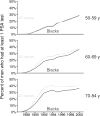Is prostate cancer different in black men? Answers from 3 natural history models
- PMID: 28436011
- PMCID: PMC5459620
- DOI: 10.1002/cncr.30687
Is prostate cancer different in black men? Answers from 3 natural history models
Abstract
Background: Black men in the United States have substantially higher prostate cancer incidence rates than the general population. The extent to which this incidence disparity is because prostate cancer is more prevalent, more aggressive, and/or more frequently diagnosed in black men is unknown.
Methods: The authors estimated 3 independently developed models of prostate cancer natural history in black men and in the general population using an updated reconstruction of prostate-specific antigen screening, based on the National Health Interview Survey in 2005 and on prostate cancer incidence data from the Surveillance, Epidemiology, and End Results program during 1975 through 2000. By using the estimated models, the natural history of prostate cancer was compared between black men and the general population.
Results: The models projected that from 30% to 43% (range across models) of black men develop preclinical prostate cancer by age 85 years, a risk that is (relatively) 28% to 56% higher than that in the general population. Among men who had preclinical disease onset, black men had a similar risk of diagnosis (range, 35%-49%) compared with the general population (32%-44%), but their risk of progression to metastatic disease by the time of diagnosis was from 44% to 75% higher than that in the general population.
Conclusions: Prostate cancer incidence patterns implicate higher incidence of preclinical disease and higher risk of metastatic progression among black men. The findings suggest screening black men earlier than white men and support further research into the benefit-harm tradeoffs of more aggressive screening policies for black men. Cancer 2017;123:2312-2319. © 2017 American Cancer Society.
Keywords: cancer epidemiology; mass screening; natural history; prostate-specific antigen; prostatic neoplasms; racial disparities; statistical methods and models.
© 2017 American Cancer Society.
Conflict of interest statement
EAMH and HJK received a research grant from Beckman Coultier. All other authors declare no potential conflict of interest.
Figures



Comment in
-
Prostate cancer in black men: Is it time for personalized screening approaches?Cancer. 2017 Jun 15;123(12):2203-2205. doi: 10.1002/cncr.30685. Epub 2017 Apr 24. Cancer. 2017. PMID: 28436012 No abstract available.
References
-
- Powell IJ. Epidemiology and pathophysiology of prostate cancer in African-American men. Journal of Urology. 2007;177:444–449. - PubMed
-
- Underwood W, De Monner S, Ubel P, Fagerlin A, Sanda MG, Wei JT. Racial/ethnic disparities in the treatment of localized/regional prostate cancer. Journal of Urology. 2004;171:1504–1507. - PubMed
MeSH terms
Substances
Grants and funding
LinkOut - more resources
Full Text Sources
Other Literature Sources
Medical
Miscellaneous

